Articles
- Page Path
- HOME > J Korean Acad Nurs > Volume 38(4); 2008 > Article
-
Original Article
- Effects of Eye Protective Device and Ear Protective Device Application on Sleep Disorder with Coronary Disease Patients in CCU
- Yoon Jung Koo, Hyo Jung Koh
-
Journal of Korean Academy of Nursing 2008;38(4):582-592.
DOI: https://doi.org/10.4040/jkan.2008.38.4.582
Published online: August 31, 2008
1Full-time Instructor, Department of Nursing, Andong Science College, Andong, Korea.
2Professor, College of Nursing, Keimyung University, Daegu, Korea.
- Address reprint requests to: Koo, Yoon Jung. Department of Nursing, Andong Science College, 496 Gyo-ri, Seohu-myeon, Andong 760-709, Korea. Tel: 82-54-851-3660, Fax: 82-54-851-3660, lice1@kmu.ac.kr
Copyright © 2008 Korean Society of Nursing Science
Abstract
-
Purpose
- The purpose of this research was to analyze the effects of an eye protective device and ear protective device application on sleep disorder with coronary disease patients in CCU.
-
Methods
- The research design was set up as a nonequivalent control group non-synchronized design. The subjects were coronary disease patients in the CCU of a tertiary hospital. The subjects were composed of 20 in the group with an eye protective device, 18 in the group with an ear protective device, 17 in the group with an eye protective device and ear protective device and 20 in the control group. The data was analyzed by χ2-test, ANOVA, Repeated measures ANOVA, Sheffe-test, Simple main effect and Time contrast using SPSS Win 12.0.
-
Results
- The hypothesis, 'There are significant differences in sleep quantity among the four groups' was supported (F=1,342.71, p=.000). The hypothesis, 'There are significant differences in the subjective evaluation of the general sleep patterns among the four groups' was supported (F=3,638.73, p=.000). In addition the hypothesis, 'There are significant differences in degree of sleep among the four groups' was supported (F=1,616.61, p=.000).
-
Conclusion
- It is cost effective and a simple eye protective device and ear protective device should be applied to patients according to their preference and characteristics in the clinical setting.
- 1. Bently S, Murphy F, Ellis BW, Dudley D. Sleep deprivation in patients undergoing operation: A factor in stress of surgery. British Medical Journal. 1977;10:1521–1522.
- 2. Beyerman K. Etiologies of sleep pattern disturbance in hospitalized patients. Classifications of Nursing Diagnosis: Proceeding of the Seventh Conference. 1987;St. Louis, Mosby.
- 3. Byers JF, Smyth KA. Effect of a music intervention on noise annoyance, heart rate, and blood pressure in cardiac surgery patients. American Journal of Critical Care. 1997;6:183–191.ArticlePubMedPDF
- 4. Cohen J. Statistical power analysis for behavioral science. 1988;New York, Academic Press.
- 5. Foreman MD, Wykle M. Nursing standard of practice protocol: Sleep disturbances in elderly patients. The NICHE Faculty. Geriatric Nursing. 1995;16:238–243.Article
- 6. Fox MR. The importance of sleep. Nursing Standard. 1999;13(24):44–47.Article
- 7. Freedman NS, Kotzer N, Schwab RJ. Patient perception of sleep quality and etiology of sleep disruption in the intensive care unit. American Journal of Respiratory and Critical Care Medicine. 1999;159(4, Pt 1):1155–1162.ArticlePubMed
- 8. Haddock J. Reducing the effects of noise in hospital. Nursing Standard. 1994;8(43):25–28.Article
- 9. Hwang EH. Effects of hand acupuncture therapy on sleep quality in sleep disrupted adults: Verification by polysomnography and cerebral blood flow test. Journal of Korean Academy of Nursing. 2007;37:1108–1118.ArticlePubMedPDF
- 10. Jung HW. A comparative study on noise level and nurses' degree of noise perception in general hospital. Korean Journal of Occupational Health Nursing. 2001;10:174–182.
- 11. Kahn DM, Cook TE, Carlisle CC, Nelson DL, Kramer NR, Millman RP. Identification and modification of environmental noise in an ICU setting. Chest. 1998;114:535–540.ArticlePubMed
- 12. Kim KH. Quality of sleep and sleep disturbance factors of coronary artery disease patients in CCU. 2001;Seoul, Ehwa Womans University. Unpublished master's thesis.
- 13. Kim MA. A study on the sleep amount of patient and environmental factors influencing to the sleep amount in intensive care unit. 1986;Seoul, Seoul National University. Unpublished master's thesis.
- 14. Kim MJ. Effects of earplugs application on the noise-induced disturbed sleep patterns in ICU patients. 2003;Daegu, Keimyung University. Unpublished master's thesis.
- 15. Kim MY, Cho SH, Lee SM, Jung SJ, Park KS. Elderly sleep pattern and disturbing factors before and after hospitalization. Journal of Korean Academy of Nursing. 1999;29:61–71.ArticlePDF
- 16. 2003's Mortality according to Cause of Death. 2004;December 18 Retrieved March 2, 2005. Korean National Statistical Office. from http://kosis.nso.go.kr/juro/index.html.
- 17. Lee YH, Kim JS. A study on sleep deprivation factors and its influence of patients that hospitalized in general ward. Central Medical Association. 1996;61(12):96.
- 18. Masahiro T. The lighting plan a patient peacefulness. Journal of Illuminating Engineering Institute of Japan. 2004;88:675–681.
- 19. Oh JJ, Song MS, Kim SM. Development and validation of Korean sleep scale A. Journal of Korean Academy of Nursing. 1998;28:563–572.
- 20. Pacini CM, Fitzpatrick JJ. Sleep pattern of hospitalized and non-hospitalized aged individuals. Journal of Gerontological Nursing. 1982;8:327–332.PubMed
- 21. Parish JM, Shepard JW Jr. Cardiovascular effects of sleep disorder. Chest. 1990;97:1220–1226.ArticlePubMed
- 22. Park EJ. The effect of auricular acupressure on sleep, serotonin, TNF-α & IL-6 of hemodialysis patients. 2007;Jinju, Gyeongsang National University. Unpublished doctoral dissertation.
- 23. Redeker NS. Sleep in acute care setting: An integrative review. Image-The Journal of Nursing Scholarship. 2000;32:31–38.
- 24. Redeker NS, Tamburri L, Howland CL. Prehospital correlates of sleep in patients hospitalized with cardiac disease. Research in Nursing & Health. 1998;21:27–37.Article
- 25. Schwab RJ. Disturbances of sleep in the intensive care unit. Critical Care Clinics. 1994;10:681–694.ArticlePubMed
- 26. Son YJ. The relationship between noise and sleep pattern in intensive care unit. 1999;Seoul, Yonsei University. Unpublished master's thesis.
- 27. Song RH. The effect of foot reflexo-massage on the sleep, depression and physiological index of elderly. 2004;Daejeon, Chungnam National University. Unpublished doctoral dissertation.
- 28. Southwell MT. In-patient sleep disturbance: The views of staff and patients. Journal of Advanced Nursing. 1995;18:521–529.
- 29. Tae YS, Baek JH. Related factors of sleep of adult patients in hospital. Kosin Medical Journal. 2003;18:112–127.
- 30. Topf M, Bookman M, Arand D. Effects of critical care unit noise on the subjective quality of sleep. Journal of Advanced Nursing. 1996;24:545–551.ArticlePubMed
REFERENCES
Figure & Data
REFERENCES
Citations

- Effects of a Multimodal Intervention on Sleep Quality and Duration in Intensive Care Unit Patients
Jieun Nam, Sukhee Ahn
Journal of Korean Critical Care Nursing.2025; 18(1): 70. CrossRef - Non-pharmacological interventions for sleep promotion in hospitalized children
Sapna R Kudchadkar, Jessica Berger, Ruchit Patel, Sean Barnes, Claire Twose, Tracie Walker, Riley Mitchell, Jaehyun Song, Blair Anton, Naresh M Punjabi
Cochrane Database of Systematic Reviews.2022;[Epub] CrossRef - Effect of earplug/eye mask on sleep and delirium in intensive care patients
Reva Balci Akpinar, Meyreme Aksoy, Elif Kant
Nursing in Critical Care.2022; 27(4): 537. CrossRef - Effect of Eye Masks on Pain and Sleep Quality in Patients Undergoing Cardiac Surgery: A Randomized Controlled Trial
Ghada Shalaby Mahran, Matthew J. Leach, Mostafa Samy Abbas, Ahmed M. Abbas, Ahmed Mohamed Ghoneim
Critical Care Nurse.2020; 40(1): 27. CrossRef - Development and Application of an Intervention for Noise Reduction in Intensive Care Units
Sun-Hee Yun, Na-Young Kwak, Yang-Sook Yoo
Korean Journal of Adult Nursing.2020; 32(6): 584. CrossRef - Non-pharmacological interventions for sleep promotion in hospitalized children
Sapna R Kudchadkar, Sean Barnes, Blair Anton, Daniel J Gergen, Naresh M Punjabi
Cochrane Database of Systematic Reviews.2017;[Epub] CrossRef - Effect of Foot Reflexology Massage and Foot Bath on the Sleep Quality of Patients with Acute Coronary Syndrome: A Comparative Study
Mehdi Naseri, Ali Rahmani, Batool Nerir, Mehdi Salari, Maryam Moshkani Farahani
Journal of Critical Care Nursing.2016;[Epub] CrossRef - Effects of earplugs and eye masks combined with relaxing music on sleep, melatonin and cortisol levels in ICU patients: a randomized controlled trial
Rong-Fang Hu, Xiao-Ying Jiang, Kathleen M Hegadoren, You-Hua Zhang
Critical Care.2015;[Epub] CrossRef - Comparison of Domestic and International Research (1992-2011): Intensive Care Nursing Studies
Eun Hee Choi, Eun Hee Jang, Ji Youn Choi, So Jung Lee, Hyo Kuyng Seo, Kyung Sook Park
Korean Journal of Adult Nursing.2015; 27(4): 384. CrossRef - Sleep Quality and Factors affecting Sleep Disturbance among Percutaneous Coronary Angiography Patients in a General Hospital
Journal of East-West Nursing Research.2015; 21(1): 69. CrossRef - Sensory environment on health-related outcomes of hospital patients
Amy Drahota, Derek Ward, Heather Mackenzie, Rebecca Stores, Bernie Higgins, Diane Gal, Taraneh P Dean
Cochrane Database of Systematic Reviews.2012;[Epub] CrossRef - Effect of Environmental Intervention on Sleep, Emotions and Job Satisfaction of Rotating Shift Nurses in Intensive Care Unit
Hee-Ja Kim
Korean Journal of Adult Nursing.2012; 24(1): 11. CrossRef - Effects of earplugs and eye masks on nocturnal sleep, melatonin and cortisol in a simulated intensive care unit environment
Rong-fang Hu, Xiao-ying Jiang, Yi-ming Zeng, Xiao-yang Chen, You-hua Zhang
Critical Care.2010;[Epub] CrossRef - Factors Predicting Patient Discomfort after Coronary Angiography
Ae Ran Park, Ja Yun Choi
Journal of Korean Academy of Nursing.2009; 39(6): 860. CrossRef
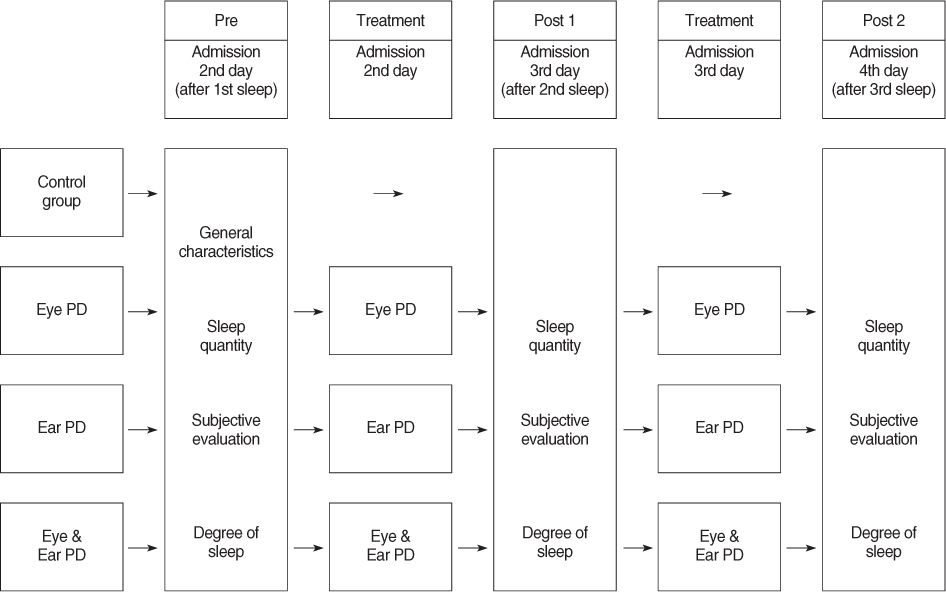
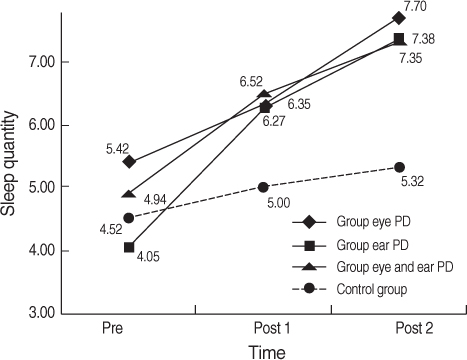
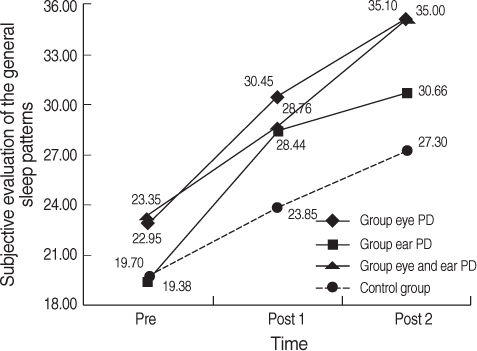
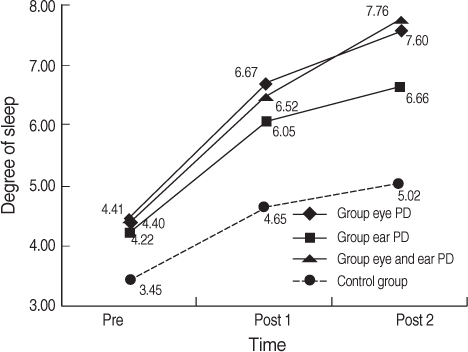
Figure 1
Figure 2
Figure 3
Figure 4
General Characteristics and Homogeneity Test
PD=protective device.
Homogeneity Test for Variables before the Therapy
PD=protective device.
Change of Sleep Quantity, Subjective Evaluation of the General Sleep Patterns and Degree of Sleep among Four Groups (N=75)
PD=protective device.
Change of Sleep Quantity, Subjective Evaluation of the General Sleep Patterns and Degree of Sleep among Four Groups by Simple Main Effect (N=75)
PD=protective device.
PD=protective device.
PD=protective device.
PD=protective device.
PD=protective device.
 KSNS
KSNS
 E-SUBMISSION
E-SUBMISSION




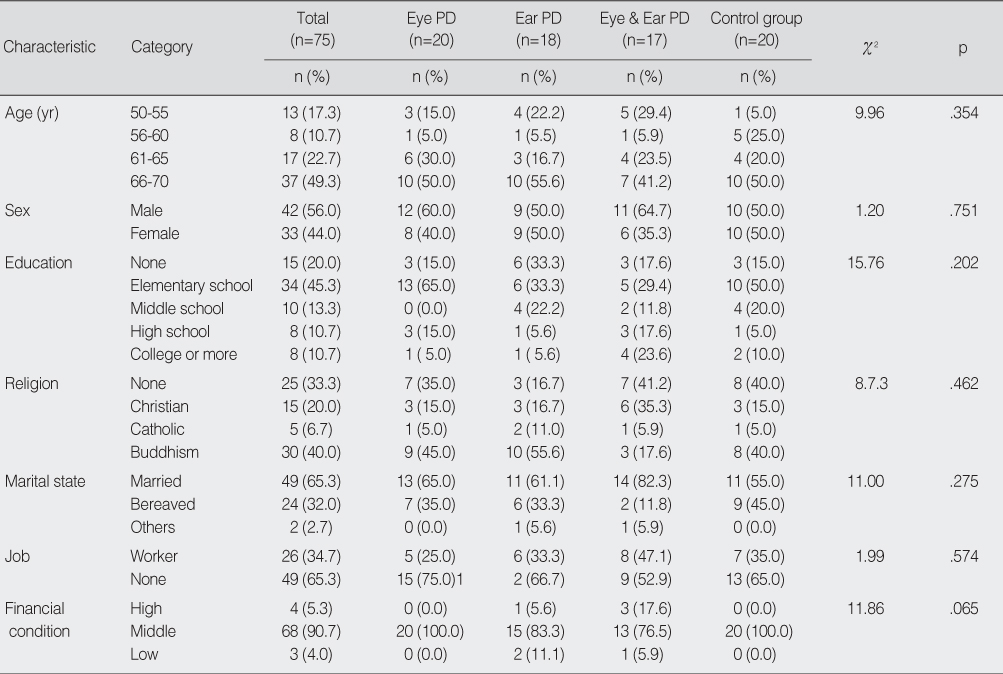
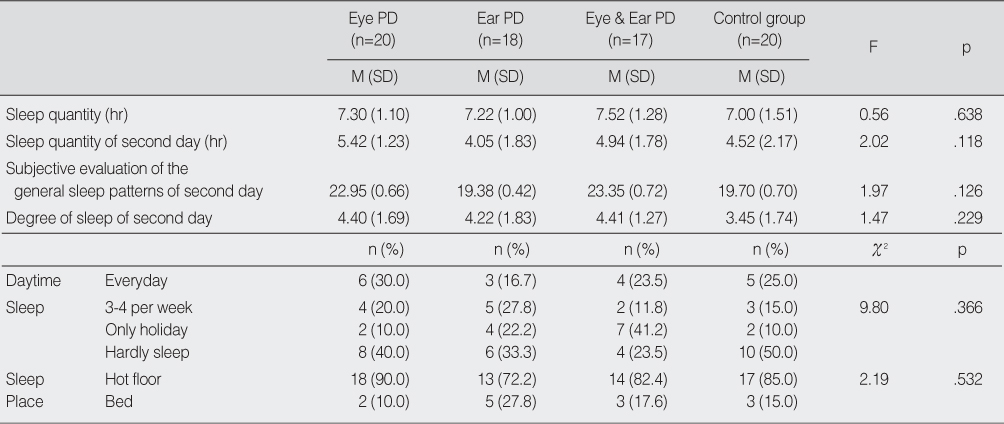
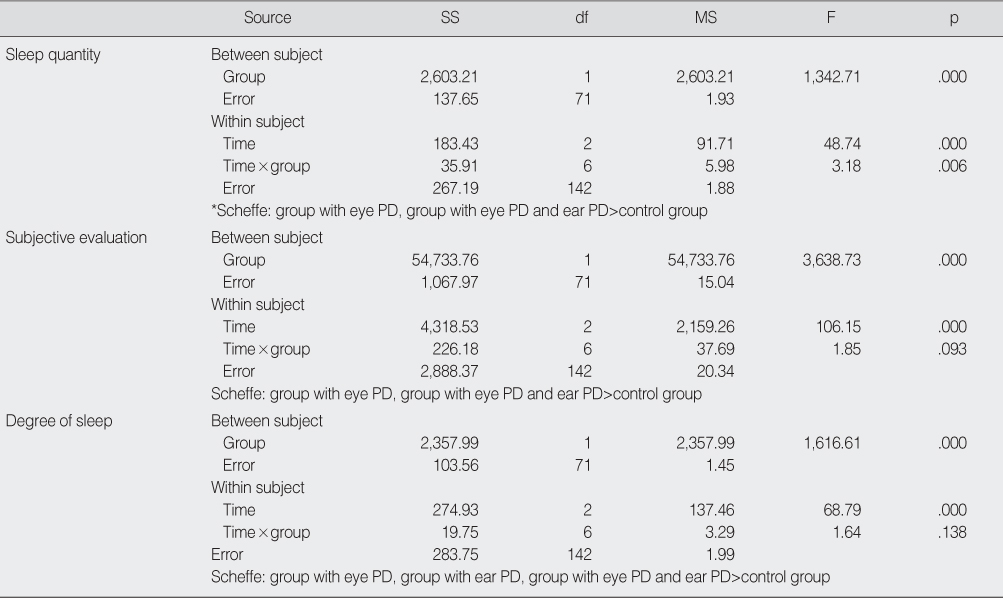

 Cite
Cite

